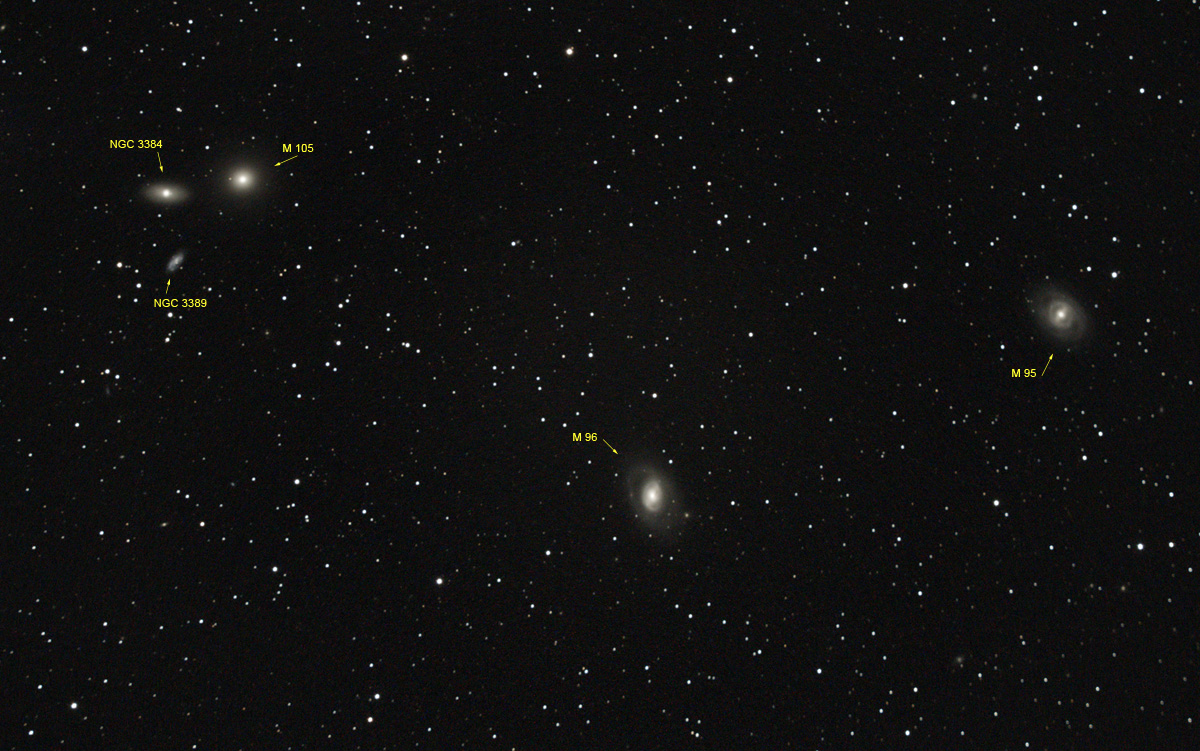
Back to Main > Back to Galaxies
M95 Barred Spiral Galaxy
Magnitude: 11.4
Distance: Aprox: 32.6 million light-years
Constellation: Leo
Diameter: 46,000 light-years
M95 is one of the fainter objects in the Messier Catalogue. Messier 95, the nearby intermediate spiral galaxy M96, and the elliptical M105 can be found roughly a third of the way from Regulus, the brightest star in Leo, to Denebola, the third brightest star in the constellation, which lies about 24 degrees east of Regulus.
---------------------------------------------------------------------
M96 Internmediate Spiral Galaxy
Magnitude: 10.1
Distance: Aprox: 31 million light-years
Constellation: Leo
Diameter: 46,000 light-years
M96 is estimated to contain about 100 billion stars. The nucleus of M96 shows a weak level of activity of the LINER2 (low ionization nuclear emission region) type. The galaxy’s bright inner disk is home to a yellow population of old stars, while the spiral arms have rings of blue knots which are open clusters of young, hot, blue stars.
---------------------------------------------------------------------
M105Elipticall Galaxy
Magnitude: 10.2
Distance: Aprox: 32 million light-years
Constellation: Leo
Diameter: 54,000 light-years
Messier 105 and its companion NGC 3384 are surrounded by a vast ring of neutral hydrogen gas. The ring has a radius of 650,000 light years (200,000 parsecs) and is a site where star forming activity has been detected. The estimated mass of the ring is about 1.8 billion solar masses. Observations with the Hubble Space Telescope have revealed that the stars near the galaxy’s centre are moving very rapidly. These findings led astronomers to conclude that M105 contains a supermassive black hole with an estimated mass between 140 and 200 million solar masses. The galaxy itself has an estimated mass of about 100 billion solar masses. A few young stars and clusters have been discovered in the galaxy, indicating that new stars do still form in some elliptical galaxies, even if the process is a very slow one, with one Sun-like star formed every 10,000 years on average.
---------------------------------------------------------------------
NGC 3384 Elliptical Galaxy
Magnitude: 10.9
Distance: Aprox: 35.1 million light-years
Constellation: Leo
NGC 3384 has a many old stars in the central region. More than 80% were found to be Population II stars which are over a billion years old. There is also a supermassive black hole at the core.
---------------------------------------------------------------------
NGC 3389 Elliptical Galaxy
Magnitude: 12.4
Distance: Aprox: 69.4 million light-years
Constellation: Leo
Taken 2/19/18 in Chiefland Florida by Russell Kille on a CPC 1100 with Hyperstar @ F2 and ZWO ASI294MC Pro camera